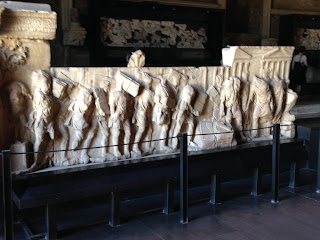Today we were privileged to be allowed inside the Curia, the old Senate building of Rome. The Curia was rebuilt several times, most notably after it burned in 52 BC during riots at the funeral of Clodius Pulcher and by Diocletian after a fire destroyed it in 283 AD.
Here is a section of the marble floor.
A porphyry statue of an unknown emperor (head is missing).
The HUGE bronze doors. These are replicas, the originals are in the church of St. John Lateran elsewhere in Rome.
A picture of our group enjoying our private, top-secret, exclusive access.
A relief from the frieze of a different temple, showing Trajan holding court.
A matching relief showing accounts being burned after Trajan enacted debt relief and cancelled people's debt.
A portion of the marble affixed to the brick wall.
A view of the Curia from outside, looking at the remnants of the columns from the Basilica Aemilia.
We then moved from the Republican Forum to the Forum of Augustus across the road. The centerpiece of the Augustan Forum was a temple he vowed to Mars Ultor (Mars the Avenger) at the Battle of Philippi when he and Marc Antony faced off against his father's assassins, Brutus and Cassius. However, it took many years to complete this project and by the time it finally got going, Augustus had a change of heart. He did no really care to remind people of an episode in what had been a civil war, so he changed the focus and concentrated on his successful negotiation with the Parthian Empire to recover the legionary standards lost when Marcus Licinius Crassus was defeated and slaughtered by them in 53 BC. The death of Crassus, a member of the first triumvirate (with Caesar and Pompey) meant Caesar lost his political support. This helped contribute to the civil war that followed, between Caesar and Pompey.
Here you can see some of the original marble paving.
On my way to our next site, I walked through Piazza Navona, home of the famous Fontana dei Quattro Fiumi sculpted by Bernini. The four rivers,
the Ganges, with an oar because the Ganges is navigable
the Nile, with his head covered since no one knew where the head of the Nile was,
the Danube, with one hand stretching to the light but the other in darkness
and the Rio del Plata, with both hands raised in surprise, as South America had only been discovered recently.
The four rivers symbolize the extent of Catholicism at the time Bernini sculpted it.
After lunch we reconvened at the site of the Mausoleum of Augustus and the Ara Pacis (Altar of Peace). Mussolini wanted to create a Piazza where Italians could reflect on the mighty deeds of their ancestors, but this was a bust. Due to the layout of the site, the Mausoleum became a hangout for junkies. For this reason, the Mausoleum is now fenced off from the public.
The Ara Pacis is still open though. This was an honor granted to Augustus by the Senate.
Marcus V. Agrippa...my man!
The actual altar inside the structure.
A hidden detail in the relief of acanthus leaves surrounding the Ara Pacis. A snake is slithering up to a birds' nest, and one of the chicks has hopped out and is running away.
At the end of our busy day, we headed to the Pantheon, originally built by Agrippa. We will return here, since the layout of the building that survives to this day was actually an extensive remodeling job done by the emperor Hadrian. Stay tuned for that.

























No comments:
Post a Comment